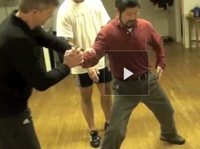 Hi there Master Chen, these past days i’ve had the same question everyday, been trying to find an answer, looked over the old videos, but didnt really help.
Hi there Master Chen, these past days i’ve had the same question everyday, been trying to find an answer, looked over the old videos, but didnt really help.
The first doubt was about the training method, specially for beginners. You told us that the training should be strong, what that means to me, in the upper body region, is that you really pull in with lots of strength and really push out(maintaining the various lines of course), so its pretty clear what strong means when you mention the arms, just use them strongly.
But, my doubt was, what about the lower body strength, the legs… Should they simply remain stable, should they occasionally push out, should you simply seek stability and structure. So I’m not sure what defines strong training when you talk about the lower body, i mean I understand whats eventually supposed to be done with the legs, specially concerning the hand-foot connections, but should that be recommended for beginners? Or only later on, when and if the kua is fully open.
The lower body can be full of detail, and really easy to toss a lot. So it begs many questions.



{ 12 comments… read them below or add one }
The upper body power must come with the help of a ceiling above your head. When you make movements, your head cannot go above the ceiling.
The lower body must follow the same principle with the ceiling on the waist. Imagine a board with a hole in the middle. You wear this board on your waist. Make sure that the board never goes upwards when you power up with your legs.
In my training, when I really powered up in my legs, I can barely finish the first 13 moves. The training can be very tedious, hard, but rewarding. When Master Chen says strong, we don’t need to interpret what he means. When a student asked me how hard to push (against a wall, referring to Master Chen’s video), I simply said “push as hard as you can.”
Thanks for the good question, though. Master Chen’s answer again enlightened me.
I agree. It is a lot of work. I’ve recently come to a greater awareness of and an ability to move my kua. I understand a little better using the legs to power the arms. I love the change in the form that new awareness brings.
I thought I was using my legs before, but I find that I was not. I don’t know where the power went. At least now, I think it is moving a little closer to its intended target.
I keep finding information on this website, like this question and answer, pop up for me right at the time that I am working on it. So fun!
I also found these 2 videos to be quite helpful on this subject.
http://practicalmethod.com/2012/10/power-up-online-video-trailer/
http://practicalmethod.com/2012/10/weight-shifting-online-video-trailer/
Its strange because these are well talked about subjects, but for whatever reason, be it simplicity or whatnot, these videos worked for me.
Cheers.
When I hear the words “strong” and “hard” as applied to the Practical Method…my understanding is “full” and/or “expanded”…to me more of an internal function…though I do not know if this is correct…just where I am at presently…
Strong means “strong” and hard means “hard”.
I think the strong and the hard are just like normal strong and hard john. It is that you just have to adhere to the principles of of the line. It is the mechanism of movement that is different.
Thanks once more Master Chen, this gives it a good image to share, specially for newcomers.
I’ve never paid attention to the ceiling on the waist. Thank you for this idea and image!
The main thing is that we must train with power. The only question is “method”.
I found this video by chance yesterday, it further explains the subject at hand. It even has some Yilu demonstration, really good.
http://practicalmethod.com/2011/03/upper-and-lower-body-coordination-online-video-trailer/
This is a good thread for students.